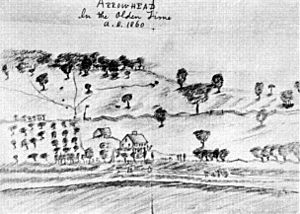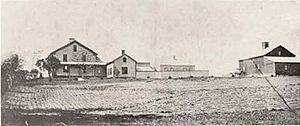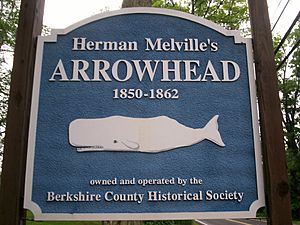Arrowhead (Herman Melville House) facts for kids
|
Arrowhead (Herman Melville House)
|
|
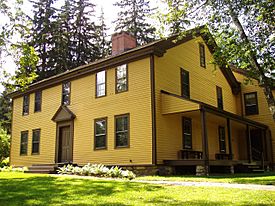
Arrowhead in 2006; the piazza (porch) is to the right
|
|
| Lua error in Module:Location_map at line 420: attempt to index field 'wikibase' (a nil value). | |
| Location | 780 Holmes Road, Pittsfield, Massachusetts |
|---|---|
| Area | 44.909 acres (18.174 ha) |
| Built | 1785 |
| Architect | Capt. David Bush |
| NRHP reference No. | 66000126 |
Quick facts for kids Significant dates |
|
| Added to NRHP | October 15, 1966 |
| Designated NHL | December 29, 1962 |
Arrowhead, also called the Herman Melville House, is a special old house in Pittsfield, Massachusetts. It was the home of a famous American writer, Herman Melville, from 1850 to 1863. During these years, Melville wrote some of his most important books here. These include the famous novel Moby-Dick, Pierre, The Confidence-Man, and Israel Potter. He also wrote a collection of short stories called The Piazza Tales, which was named after the porch at Arrowhead.
The house is located at 780 Holmes Road in Pittsfield. It was built in the 1780s as a farmhouse and an inn. Melville bought the property in 1850 and lived there for twelve years, farming and writing. In 1863, his family moved back to New York City because of money reasons. Melville then sold the house to his brother.
The house stayed with private owners until 1975. That's when the Berkshire County Historical Society bought it. The Society has brought most of the house back to how it looked when Melville lived there. Today, it is a house museum that you can visit during the warmer months. Arrowhead is recognized as a National Historic Landmark. It is also listed on the National Register of Historic Places.
Contents
Building Arrowhead: Its Early Days
The oldest parts of the house known as Arrowhead were built in the 1780s. A person named Captain David Bush built the house, which was made of wood and had clapboard siding. It was used as an inn back then.
The Bush family sold the property to a doctor named John Brewster in 1844. In 1850, Dr. Brewster sold the 160 acres (65 ha) property to the writer Herman Melville. At that time, the house was a simple rectangular building. It had five window sections across the front and two sections deep, with a large chimney in the middle.
Herman Melville's Time in Pittsfield
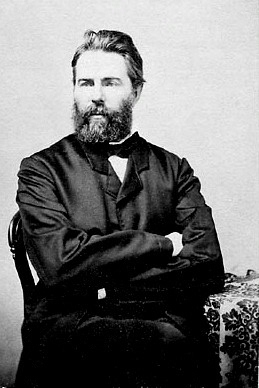
Herman Melville was born in New York City in 1819. His family moved to Albany, New York, in 1830 after they had money problems. Melville's uncle, Thomas Melvill, owned land in Pittsfield. Herman had visited this area a few times when he was younger.
In August 1831, Melville made a short visit to his uncle's farm. After his father passed away in January 1832, Melville's mother took the family to Pittsfield. They went there in July 1832 to get away from a cholera outbreak. It was during this short stay that Melville started to love the Berkshires area.
In 1837, he managed his uncle's farm while his uncle traveled for business. Melville's cousin, Priscilla, said that his connection to the area grew much stronger during this time.
In the summer of 1850, Melville, his wife Lizzie, and their son Malcolm vacationed in Pittsfield. This visit to his uncle's farm was special because his uncle was going to sell the property. It would be the family's last visit there.
On August 5, 1850, Melville met another famous writer, Nathaniel Hawthorne, for the first time. Melville had just read Hawthorne's short story collection, Mosses from an Old Manse. They were both invited to a picnic on Monument Mountain. Other important people like Evert Augustus Duyckinck and Oliver Wendell Holmes Sr. were also there.
Melville and Hawthorne quickly became friends. Melville loved the Hawthorne family and didn't want to leave the Berkshires. So, he decided to buy the Brewster farm, which was next to his uncle's land. News reports said the property had "one of the most extensive and splendid views in Berkshire."
Melville got a $3,000 loan from his father-in-law, Lemuel Shaw. He also got a $1,500 mortgage from Dr. Brewster. He promised to pay the rest of the $6,500 price when his New York lease was sold. The sale was completed on September 14, 1850. To get more money, Melville sold off 80 acres (32 ha) of the land in the 1850s.
Life and Writing at Arrowhead
Melville named his new home Arrowhead because people often found arrowheads on the property. These were found when they were planting crops. A publisher from New York, Evert Augustus Duyckinck, wrote that Arrowhead's "grounds would satisfy an English nobleman." He admired the "noble maples and elms and various seclusions and outlooks."
In August 1850, Melville described his daily routine to Duyckinck:
I rise at eight—thereabouts—& go to my barn—say good-morning to the horse, & give him his breakfast. (It goes to my heart to give him a cold one, but it can't be helped.) Then, pay a visit to my cow—cut up a pumpkin or two for her, & stand by to see her eat it—for it's a pleasant sight to see a cow move her jaws—she does it so mildly and with such a sanctity.—My own breakfast over, I go to my work-room & light my fire—then spread my M.S.S. on the table—take one business squint at it, & fall to with a will. At 2 1/2 P.M. I hear a preconcerted knock at my door, which (by request) continues till I rise & go to the door, which serves to wean me effectively from my writing, however interested I may be. My friends the horse & cow now demand their dinner—& I go & give it to them.
It was at Arrowhead that Melville finished his famous novel Moby-Dick. Even though the book was not well-known when he was alive, it is now considered one of the greatest American stories ever written. Nathaniel Hawthorne greatly influenced Melville while he was writing Moby-Dick. Melville wrote a review of Hawthorne's Mosses from an Old Manse. In it, he felt that Hawthorne's stories showed a dark side, "shrouded in blackness, ten times black." Moby-Dick was dedicated to Hawthorne. Melville wrote: "In token of my admiration for his genius, this book is inscribed to Nathaniel Hawthorne."
Hawthorne also mentioned Melville in his book A Wonder-Book for Girls and Boys. He wrote: "On the higher side of Pittsfield, sits Herman Melville, shaping out the gigantic conception of his 'White Wale' while the gigantic shape of Graylock looms upon him from his study-window."
Melville used parts of Arrowhead in some of his stories. The piazza, or porch, was added to the north side of Arrowhead soon after Melville bought the property. The Piazza Tales was named after this porch. Most houses in the Berkshires had porches facing south. But Melville chose to face his porch toward Mount Greylock. He even dedicated his book Pierre to the mountain.
About the piazza, he wrote:
Now, for a house, so situated in such a country, to have no piazza for the convenience of those who might desire to feast upon the view, and take their time and ease about it, seemed as much of an omission as if a picture-gallery should have no bench; for what but picture-galleries are the marble halls of these same limestone hills?—galleries hung, month after month anew, with pictures ever fading into pictures ever fresh.
In his story "I and My Chimney," published in 1856, he described Arrowhead's large chimney:
It need hardly be said, that the walls of my house are entirely free from fire-places. These all congregate in the middle—in the one grand central chimney, upon all four sides of which are hearths—two tiers of hearths—so that when, in the various chambers, my family and guests are warming themselves of a cold winter’s night, just before retiring, then, though at the time they may not be thinking so, all their faces mutually look towards each other, yea, all their feet point to one centre; and when they go to sleep in their beds, they all sleep round one warm chimney.
Melville lived, farmed, and wrote at Arrowhead for 13 years. He had visitors like Hawthorne, Holmes, and Catharine Maria Sedgwick. Other well-known books he wrote there include Israel Potter and The Confidence-Man. He also wrote stories like "Bartleby, the Scrivener" and "Benito Cereno". These stories were later put into The Piazza Tales.
During this time, his writing did not earn him much money. To help his family's finances, the Melvilles moved into Pittsfield in 1862. The next year, he sold Arrowhead to his brother Allan. The Melvilles then moved back to New York City. There, Herman eventually found work as a customs inspector.
Arrowhead After Melville's Time
Melville continued to visit Arrowhead sometimes while his brother owned it. Members of the Melville family owned the house until 1927. It remained privately owned until 1975. That's when the Berkshire County Historical Society bought the house.
Over the years, much of the original land was sold off. Only 14.2 acres (5.7 ha) remained when the society bought it. However, a lot of this land is still open space. The society later bought another 30.7 acres (12.4 ha). Owners after Herman Melville added large parts to the house, mainly two side sections. The porch was removed in the 1900s. But a large window was added on the north side to keep the view of Mount Greylock. Arrowhead was named a National Historic Landmark in 1962.
Visiting the Arrowhead Museum
After buying the property, the Historical Society worked to make it look like it did when Melville lived there. Many changes inside the house were undone. Windows that had been changed were put back to their original size. The piazza, or porch, was also rebuilt. The Society also restored the upstairs study where Melville wrote his books. They made it look like it did in his time.
Arrowhead is now a non-profit historic house museum. The Berkshire County Historical Society runs it. They use part of the house as their offices. The rest of the house is open to the public for tours. You can visit during the warmer months of the year. It is located at 780 Holmes Road. The museum is open from Memorial Day to Columbus Day.
More Places to Explore
- Herman Melville House, in Troy, New York, where Melville lived from 1838 to 1847.
- National Register of Historic Places listings in Berkshire County, Massachusetts
- List of National Historic Landmarks in Massachusetts
- List of residences of American writers


